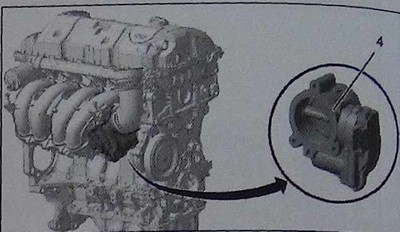Since the variable valve lift system does not need a throttle valve to dose the amount of air supplied, the functions of the valve are reduced to constantly maintaining a vacuum of 50 mbar in the intake manifold, which is necessary to release fuel vapor and oil vapor from the canister system.

In addition, the throttle valve is used in emergency operation of the engine in the event of a malfunction of the valve lift change system.
The throttle valve operating modes are shown in the following figure.
With the ignition off, the emergency mode spring holds the throttle in the open position (view «WITH»).
When the ignition is turned on, the engine ECU moves the throttle to the idle position, overcoming the force of the emergency mode spring (view «D»).
When the engine is idling, the throttle valve moves to supply the required amount of air to the engine (replacing the idle speed motor with a stepper motor).
Starting from 1500 rpm, the engine ECU moves the throttle in the other direction, helping the spring (view «E»).
The throttle position is monitored by the engine ECU thanks to a potentiometer integrated into the throttle body.
The engine ECU turns off power to the throttle valve when certain malfunctions occur.
Throttle body connector pin assignment:
- pin 1 - power supply 5 V;
- pin 1 - signal 2;
- contact 1 — «weight»;
- pin 1 - signal 1;
- contact 1 — «positive» team;
- contact 1 — «negative» team.
